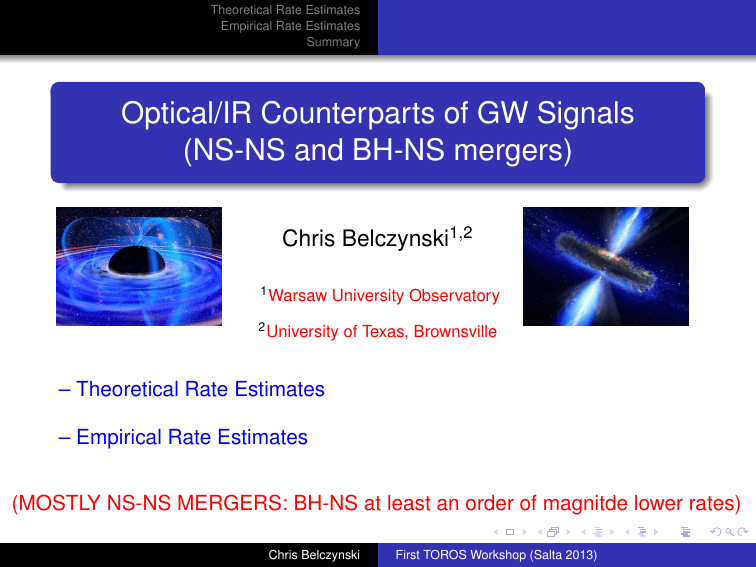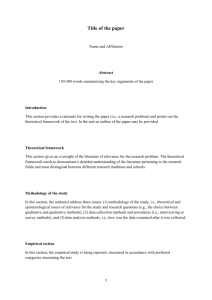Optical/IR Counterparts of GW Signals (NS-NS and BH
advertisement

Theoretical Rate Estimates Empirical Rate Estimates Summary Optical/IR Counterparts of GW Signals (NS-NS and BH-NS mergers) Chris Belczynski1,2 1 Warsaw University Observatory 2 University of Texas, Brownsville – Theoretical Rate Estimates – Empirical Rate Estimates (MOSTLY NS-NS MERGERS: BH-NS at least an order of magnitde lower rates) Chris Belczynski First TOROS Workshop (Salta 2013) Theoretical Rate Estimates Empirical Rate Estimates Summary Population Synthesis + Cosmology Calculation 1) Population Synthsis: NS-NS, BH-NS – initial conditions – binary evolution – rates per unit mass/delay times 2) Cosmology: – star formation history – metallicity evolution – rates per unit time 3) Results: – low z: NS-NS dominate: 10–50 mergers per year to z = 0.1 – BH-NS much lower rates: < 1 merger to z = 0.1 (450Mpc) Chris Belczynski First TOROS Workshop (Salta 2013) Theoretical Rate Estimates Empirical Rate Estimates Summary Conversion to Optical/IR Brightness 4) Conversion Scheme – redshift (z) -> luminosity distance (LD ) – kilonova absolute brightness: MK = −16mag (D.Kasen) MJ = −15mag (D.Kasen) MI = −13mag (D.Kasen) MV = −12mag (D.Kasen) – apparent brightness for each LD : mI = MI + 5(log(LD ) − 1) – LD -> apparent mK , mJ , mI , mV –> Kilonova rate for a survey depth (or limiting magnitude) (modulo extinction and K-correction) Chris Belczynski First TOROS Workshop (Salta 2013) Theoretical Rate Estimates Empirical Rate Estimates Summary Kilonova Optical/IR Brightness – to have 1 kilonova per year we need survey depth (ENTIRE SKY): 20mag (K), 21mag (J), 23mag (I), 24mag (V) ... Chris Belczynski First TOROS Workshop (Salta 2013) Theoretical Rate Estimates Empirical Rate Estimates Summary Kilonova Optical/IR Brightness – to have 1 kilonova per year we need survey depth (100 deg2 ): 25mag (K), 26mag (J), 28mag (I), 29mag (V) ... Chris Belczynski First TOROS Workshop (Salta 2013) Theoretical Rate Estimates Empirical Rate Estimates Summary Kilonova Optical/IR Brightness – to have 1 kilonova per year we need survey depth (100 deg2 ): 23mag (K), 24mag (J), 26mag (I), 27mag (V) ... 1m Schmidt telescope (100 deg2 /1 day cadence): max. depth 23mag (I-band) Chris Belczynski First TOROS Workshop (Salta 2013) Theoretical Rate Estimates Empirical Rate Estimates Summary Existing LIGO/VIRGO Upper Limits – S6 upper limits not violated even by most optimistic pop. synth. models – closest approach: factor of ∼ 4 for BH-BH with Mtotal ≈ 60M – we will now only consider NS-NS mergers: first bin on this plot LIGO/VIRGO UPPER LIMITS POPULATION SYNTHESIS 0 20 40 Chris Belczynski 60 80 100 First TOROS Workshop (Salta 2013) 120 Theoretical Rate Estimates Empirical Rate Estimates Summary Existing Short GRB Rate Estimates – assume that: "Short GRB = NS-NS merger" – use only GRBs with known redshifts and with z < 1: 27 events – estimate true number of events with z < 1: figure out luminosity function? come up with model for SWIFT GRB trigger correct for sky coverage remove potential contamination from Soft Gamma-ray repeaters correct for beaming (fb = 50 − 100, but could be 10...) Rate: 500 − 1000 Gpc−3 yr−1 (pop. synthesis: 100 Gpc3 yr−1 ) (? Batse GRBs are usually used for luminosity function) Chris Belczynski First TOROS Workshop (Salta 2013) Theoretical Rate Estimates Empirical Rate Estimates Summary Existing Radio NS-NS Rate Estimates – all known NS-NS discovered in radio: 9 binaries (predicted in the field: 100,000-300,000 binaries) – use only field "close" NS-NS (tdelay < 13.7 Gyr): 5 binaries – estimate true number of field close NS-NS bianries: figure out luminosity function (tip of the iceberg) correct for radio survey biases correct for sky coverage correct for beaming Galactic Merger Rate: 3 − 190 Myr−1 (pop. synthesis: 10-20 Myr−1 ) Chris Belczynski First TOROS Workshop (Salta 2013) Theoretical Rate Estimates Empirical Rate Estimates Summary Summary merger rates: radio NS-NS, short GRBs, pop. synthesis all rates agree within errors (pop. synthesis on the low side) detection rates: kilonova models (Metzger, Kasen, Tanaka) 10-100 events per year (entire sky) for I=24-25mag (K=21-22mag, V=25-26mag) blind surveys: telescopes larger than 1m (at first: aLigo) deep exposures: smaller telescopes (later: with iLigo+KAGRA) – how to distinguish a kilonova from a fading GRB afterglow? (GRB: mV ∼ 24 − 25mag) – what is the absolute minimum rate that can not be excluded??? Chris Belczynski First TOROS Workshop (Salta 2013) Theoretical Rate Estimates Empirical Rate Estimates Summary Population Synthesis Rate Estimates Table 1 Advanced LIGO/VIRGO Detection Rates [yr−1 ] Model S V5 V6 V7 V8 V9 V10 V11 V12 V13 a NS-NS BH-NS BH-BH comments 3.9 (1.3) 3.9 (1.3) 3.9 (1.3) 5.0 (1.5) 3.9 (1.3) 3.9 (1.3) 5.2 (1.7) 3.9 (1.1) 11.7 (0.8) 3.7 (0.9) 9.7 (5.1) 9.4 (4.8) 9.3 (4.7) 14.8 (8.3) 1.2 (0.3) 11.8 (6.7) 5.7 (4.9) 10.5 (6.3) 7.6 (5.8) 76.9 (62.1) 7993.4 (518.7) 8057.8 (533.7) 8041.7 (523.6) 8130.1 (574.2) 172.2 (14.0) 8363.6 (654.9) 7762.7 (487.0) 12434.4 (888.1) 8754.6 (275.3) 1709.6 (966.1) standard MNS,max = 3 M" MNS,max = 2 M" half NS kicks high BH kicks no BH kicks delayed SN low winds RLOF: conservative RLOF: non-conservative a Optimistic (realistic) rates are given under assumption that CE phase initiated by Hertzsprung gap donors with no clear core-envelope structure may lead to the formation of double compact object binary (always halts binary evolution). Chris Belczynski First TOROS Workshop (Salta 2013) Theoretical Rate Estimates Empirical Rate Estimates Summary Upper Limits Only: BH-BH detection rates – two families of models: Rdet = 500 yr−1 and Rdet = 5000 yr−1 (even the very high rates are ∼ 10 below current LIGO upper limits) – CE physics + stellar structure (Hertzsprung gap – stars) low rates: HG stars don’t have clear core-envelope structure high rates: either HG stars don’t expand or they survive CE – caveat1: degeneracy with metallicity – caveat2: degeneracy with BH natal kicks – BH kick EM observations: inconclusive at the – moment -> figure (if anything, they seem to support our standard kick model) Chris Belczynski First TOROS Workshop (Salta 2013) Theoretical Rate Estimates Empirical Rate Estimates Summary Common Envelope (CE) + Hertzsprung gap (HG) star BH-BH formation: CE orbital contraction Chris Belczynski First TOROS Workshop (Salta 2013) Theoretical Rate Estimates Empirical Rate Estimates Summary BH natal kicks – empirical estimates 500 400 300 200 100 0 0 5 Chris Belczynski 10 15 First TOROS Workshop (Salta 2013) Theoretical Rate Estimates Empirical Rate Estimates Summary BH natal kicks – theoretical prediction 500 400 300 200 100 0 0 5 Chris Belczynski 10 15 First TOROS Workshop (Salta 2013) Theoretical Rate Estimates Empirical Rate Estimates Summary Few Detections: BH natal kicks – BH-BH mergers predicted to dominate GR detections by 2 orders of magnitude over NS-NS Independent of SN models, winds, max NS mass, CE/RLOF treatment: no NS-NS expected in first tens of detections – The way to make BH-BH decrease significantly in numbers: (i) decrease number od stars at low metallicity (ii) give BH high natal kicks, e.g., ∼ 200 − 300 km s−1 NS-NS expected in first detections – BH kick models : low kicks (decreasing with BH mass): asymmetric mass ejection high kicks: (potentialy) asymmetric neutrino emission Chris Belczynski First TOROS Workshop (Salta 2013) Theoretical Rate Estimates Empirical Rate Estimates Summary Observations: known double compact objects BH-BH: not observed (but IC10 X-1, NGC300 X-1 -> 2000 yr−1 ) BH-NS: not observed (Cyg X-1: 0.01 yr−1 , Cyg X-3: 0.1 yr−1 ) NS-NS: 9 Galactic systems. 6 are close binaries: 4 − 200 yr−1 Phone # ——————– 1) J0737-3039 2) B2127+11C 3) J1906+0746 4) B1913+16 5) J1756-2251 6) B1534+12 tmrg /Gyr ———– 0.09 0.22 0.30 0.33 1.7 2.7 Mns,1 /M ———1.34 1.36 1.25 1.44 1.39 1.33 Mns,1 /M ——– 1.25 1.38 1.37 1.39 1.18 1.35 Comment ————– field (double pulsar) cluster field field field field – Empirical Galactic merger rate 3-190 × 10−6 yr−1 (Kim et al. 2010) (population synthesis predictions: 0.3-77 × 10−6 yr−1 ) – low contribution from cluster NS-NS binaries Chris Belczynski First TOROS Workshop (Salta 2013) Theoretical Rate Estimates Empirical Rate Estimates Summary BH-BH progenitors: IC10 X-1/NGC300 X-1 1) Massive binaries: BH + WR – Porb ∼ 30 h (Vorb ∼ 600 km/s) – MBH1 ∼ 15 − 30 M – MWR ∼ 15 − 35 M IC BH-BH: 23 M + 13 M (Mc =15 M ) NGC BH-BH: 15 M + 11 M (Mc =11 M ) 2) Very simple evolution: – WR: heavy mass loss – WR: core collapse/supernova – BH-BH: formed (tmerger ∼ 1Gyr) 3) GR detection rate: – Evolution: short lifetime 0.5 Myr – Discovery: X-ray binary upto 2 Mpc – aLIGO/VIRGO: upto 1-2 Gpc GR detection rate: ∼ 2000 yr−1 Chris Belczynski First TOROS Workshop (Salta 2013) Theoretical Rate Estimates Empirical Rate Estimates Summary BH-NS progenitor: Cygnus X-1 1) Massive binary: BH + O star BH-NS: 18 M + 1.4 M (Mc =4 M ) – MBH1 ∼ 15 M (Porb = 5.6d ) 80 – MO ∼ 19 M (RO ≈ 16 R , RRoche ≈ 17 R ) 60 2) 2-step evolution/3 outcomes: – RLOF: mass loss BH(18 M ) + WR(4 M ) – SN: supernova WR(3.5 M ) -> NS(1.4 M ) – disrupted BH/NS; wide BH-NS; close BH-NS (∼ 70%) (∼ 30%) (. 1%) 40 20 0 20 15 10 3) GR detection rate: – Evolution: lifetime 10 Myr – Observations: only 1 system in Galaxy – Advanced LIGO/VIRGO: upto 800 Mpc 5 Empirical GR detection: 1 per century (lower limit) (population synthesis: 0.3 − 80 per year) 8.7 8.8 Belczynski, Bulik & Bailyn 2011, ApJ, 742, L2 Chris Belczynski First TOROS Workshop (Salta 2013) 8.9 9 9.1 Theoretical Rate Estimates Empirical Rate Estimates Summary Science with Inspiral Detections (1) First sources: type of binary – BH-BH: rates will discriminate CE models 1/hr vs 1/(day-month) – NS-NS: only one model allows for this: high BH kicks (SN science) (2) Many sources: mass of merging compact objects – the formation of NS/BH (mass gap: real or not?) – the maximum mass of a star? (IMF: PopI/II) (3) Major (known) sources of uncertainty: – Common envelope and metallicity – Supernovae (compact object mass and kicks) (4) Other (un-assessed) sources of uncertainty: – rotation – convection Chris Belczynski First TOROS Workshop (Salta 2013) Theoretical Rate Estimates Empirical Rate Estimates Summary Dynamical Mass Estimates: NS (50) and BH (20) OBSERVATIONS ( Galactic XRBs ) “Mass Gap” N NS BH 1 2 5 10 15 MASS [M] Chris Belczynski First TOROS Workshop (Salta 2013) Theoretical Rate Estimates Empirical Rate Estimates Summary Burning: Radiative (MZAMS < 20M ) vs Convective STELLAR STRUCTURE 40M D E N S I T Y 25M 20M 14M 8M 0 r/R∗ Chris Belczynski R∗ First TOROS Workshop (Salta 2013) Theoretical Rate Estimates Empirical Rate Estimates Summary Explosion: Rapid (tSN < 0.2s) vs Delayed (tSN ≈ 1s) SUPERNOVA ENGINE STANDING ACCRETION SHOCK INSTABILITIES RAYLEIGH TAYLOR INSTABILITY 15 M MNS/BH 5 GAP 2 BH 5 3 NS 1.5 14 BH 15 M MNS/BH cold/dense (low S) on top of hot/rare (high S) (DELAYED) SASI (RAPID) R-T 1.5 20 40 Chris Belczynski MZAMS [M ] 14 First TOROS Workshop (Salta 2013) 20 40 Theoretical Rate Estimates Empirical Rate Estimates Summary SN Model + IMF + Binary Evolution = Galactic XRBs Chris Belczynski First TOROS Workshop (Salta 2013) Theoretical Rate Estimates Empirical Rate Estimates Summary Observations: known BH masses 4 − 15M : Galactic BHs (Z ∼ Z ) – 17 transients: low mass companion – 3 persistent: massive companion (Casares, Bailyn, Orosz, Charles, Greiner, ......) 8, 11M : LMC X-3, X-1 (Z ∼ 30%Z ) – HMXBs: massive companions (Orosz 02, Orosz et al. 09) 16M : M33 X-7 (Z ∼ 5 − 40%Z ) – massive 70M close companion (Orosz et al. 07) ∼ 20M : NGC300 X-1 (Z ∼ 60%Z ) – massive 26M close WR companion – (Crowther et al. 2010) ∼ 30M : IC10 X-1 (Z ∼ 30%Z ) – massive 17M close WR companion (Prestwich et al. 07) Stars at low metallicity form massive BHs: How massive can a BH get? Chris Belczynski First TOROS Workshop (Salta 2013) Theoretical Rate Estimates Empirical Rate Estimates Summary Predictions: calculation of BH masses 1) update on Hurley et al. stellar winds single star models new wind mass loss rates (Vink et al.) estimate BH mass (SN hydro) 2) new BH mass estimates: systematically higher BH mass steep increase of BH mass with decreasing metallicity (smaller winds) New Winds (Vink et al.): Z = 1.0 Z : max. BH mass: ∼ 15M Z = 0.3 Z : max. BH mass: ∼ 30M Z = 0.01 Z : max. BH mass: ∼ 80M Belczynski, Bulik, Fryer, Ruiter, Valsecchi, Vink & Hurley 2010, ApJ 714, 1217 Chris Belczynski First TOROS Workshop (Salta 2013) Theoretical Rate Estimates Empirical Rate Estimates Summary BH-BH progenitors: IC10 X-1/NGC300 X-1 1) Massive binaries: BH + WR – Porb ∼ 30 h (Vorb ∼ 600 km/s) – MBH1 ∼ 15 − 30 M – MWR ∼ 15 − 35 M IC BH-BH: 23 M + 13 M (Mc =15 M ) NGC BH-BH: 15 M + 11 M (Mc =11 M ) 2) Very simple evolution: – WR: heavy mass loss – WR: core collapse/supernova – BH-BH: formed (tmerger ∼ 1Gyr) 3) GR detection rate: – Evolution: short lifetime 0.5 Myr – Discovery: X-ray binary upto 2 Mpc – Initial LIGO/VIRGO: upto 200 Mpc GR detection rate: ∼ 0.4–10 yr−1 !!! Bulik, Belczynski & Prestwich 2011, ApJ, 730, 140 Chris Belczynski First TOROS Workshop (Salta 2013) Theoretical Rate Estimates Empirical Rate Estimates Summary . Observations: chemical composition of stars Panter et al. 2008: SDSS sample: ∼ 30, 000 galaxies recent star formation: . 1Gyr – 50%: solar metallicity ( Z ) – 50%: sub-solar metallicity (0.1 Z ) Stellar observations/models: solar metallicity: – max BH mass: ∼ 15 M (GRS 1915) – large stellar radii -> messy interactions sub-solar metallicity: – max BH mass: ∼ 30 M (IC10 X-1) – small stellar radii -> clean interactions Chris Belczynski First TOROS Workshop (Salta 2013) Theoretical Rate Estimates Empirical Rate Estimates Summary Common Envelope (CE) + Hertzsprung gap (HG) star BH-BH formation: CE orbital contraction 1) HG: no clear core-envelope boundary – CE survival? YES (A) / NO (B) . 2) Many HG stars in CE? – high metal.: YES -> very few BH-BH – low metal.: NO -> many BH-BH LIGO/VIRGO detection rates: Initial LIGO: A close to upper limits Advanced LIGO: model B – NS-NS small contribution (1/500) – BH-NS moderate contribution (1/100) – BH-BH dominate (the first source) d0,nsns = 50–100 Mpc: 1–10 detections Population Synthesis Detection Rates [yr−1 ] (2 stellar populations: 50% solar + 50% sub-solar metals) ————————————————————————— ————————————————————————— Sensitivity Type Rate A (B) ——————————————————NS-NS 3.9 (1.3) 450 Mpc (Advanced) BH-NS 9.7 (5.1) BH-BH 7993 (519) ————————————————————————— ————————————————————————— Belczynski et al. 2010, ApJ 715, L138; Dominik et al. 2012, ApJ 759, 52 Chris Belczynski First TOROS Workshop (Salta 2013) Theoretical Rate Estimates Empirical Rate Estimates Summary Common Envelope (CE) + Hertzsprung gap (HG) star BH-BH formation: CE orbital contraction 1) HG: no clear core-envelope boundary – CE survival? YES (A) / NO (B) . 2) Many HG stars in CE? – high metal.: YES -> very few BH-BH – low metal.: NO -> many BH-BH LIGO/VIRGO detection rates: Initial LIGO: A close to upper limits Advanced LIGO: model B – NS-NS small contribution (1/500) – BH-NS moderate contribution (1/100) – BH-BH dominate (the first source) d0,nsns = 50–100 Mpc: 1–10 detections Population Synthesis Detection Rates [yr−1 ] (2 stellar populations: 50% solar + 50% sub-solar metals) ————————————————————————— ————————————————————————— Sensitivity Type Rate A (B) ——————————————————NS-NS 3.9 (1.3) 450 Mpc (Advanced) BH-NS 9.7 (5.1) BH-BH 7993 (519) ————————————————————————— ————————————————————————— Belczynski et al. 2010, ApJ 715, L138; Dominik et al. 2012, ApJ 759, 52 Chris Belczynski First TOROS Workshop (Salta 2013)






